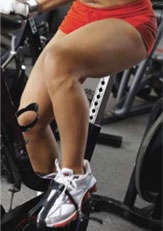
Eight conservative treatment options should be considered and discussed with your surgeon before considering surgery for a knee injury:
- Physical Activity/Exercise: Exercise that improves muscle strength, balance and joint range of motion is often effective in relieving pain. Increased strength decreases pressures on the joint surface and an increased range of motion allows for better tissue flexibility and joint lubrication. Sometimes a guided physical therapy program is helpful. You may want to enlist the help of a personal trainer or a guided self –rehabilitation video.
- Weight Loss: Joint pressure is decreased exponentially by weight loss. This means that for each pound that is lost, the effect is more like three to five pounds less for the joint, which is almost a full-proof method for reducing knee pain, due to arthritis, chondromalacia (softening or degeneration of the cartilage) or other knee pathology.
- Non-Prescription Medication: Over-the-counter medications, including non-steroidal anti-inflammatories, such as Aleve, Motrin and Advil are helpful in reducing inflammation and pain. Long-term use is not recommended, because of possible effects on tissue healing and kidney or liver damage. Tylenol (acetaminophen) can also be helpful in reducing pain.
- Prescription Medication: Non-steroidal anti-nflammatory medications are also available in higher strength prescription doses. Medications such as Naprosyn, Celebrex, Mobic, Relafen and DayPro have been reliable in treating inflammation and pain. Long=term use is not recommended. Oral steroidal anti-inflammatories have also been useful for pain reduction in severe cases.
- Dietary Supplements: Some studies have shown positive effects for relieving inflammation by using Glucosamine/Chondroitan Sulphate. Use a well-recognized brand, because regulatory parameters for supplements are not as strict as with standard medication.
- Bracing/Shoe Inserts: Bracing may offer increased stability while decreasing pain. Specialized bracing (unloader braces) can also reduce weight bearing on the degenerative portion of the knee…Ask your surgeon about shoe inserts.
- Corticosteroid Injections: These localized injections help reduce inflammation and pain for a variable period of time. They are very useful, but if used excessively, can cause articular cartilage degeneration to accelerate. Urban legend does not look favorably upon this type of injection. However, with proper use, there are few negative side effects.
- Viscosupplementation / Hyaluronic Acid Injection: This injection is formulated from rooster combs (fleshy crest on the top of the head) that contain some of the basic components of cartilage. There are several brands, including Synvisc, Hyalgan, Orthovisc, Supartz and Euflexxa. If effective, inflammation is relieved for about six months to one year after three to five weekly injections. Occasionally, some individuals are allergic to the medication, but this is easily controlled.
